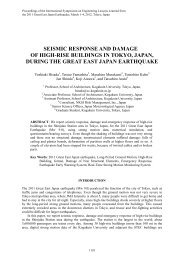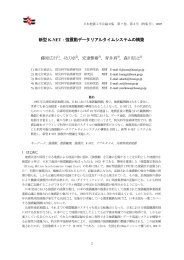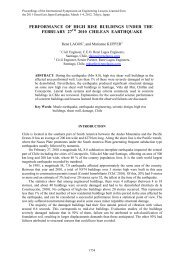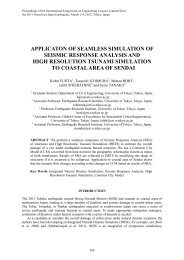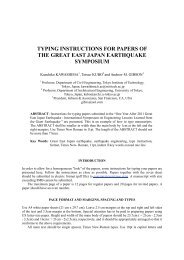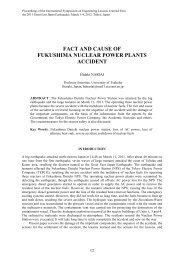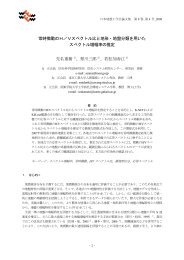Seismic Response Analysis of a Semi-active-controlled Base ...
Seismic Response Analysis of a Semi-active-controlled Base ...
Seismic Response Analysis of a Semi-active-controlled Base ...
You also want an ePaper? Increase the reach of your titles
YUMPU automatically turns print PDFs into web optimized ePapers that Google loves.
direct optimization method <strong>of</strong> structural parameters to minimize an error in a response time history(hereafter Direct method). The natural periods and damping factors <strong>of</strong> the system are identified and thestructural parameters, i.e. stiffness and damping coefficients, are updated from those assumed indesign. As the amplitude and the duration <strong>of</strong> this earthquake are abnormally important, the accuracy <strong>of</strong>the identification is improved by neglecting measure noises and using the large available quantity <strong>of</strong>data.Then, using the identified model, the performance <strong>of</strong> the semi-<strong>active</strong> base isolation system isanalyzed based on a response simulation with based on a record <strong>of</strong> an aftershock <strong>of</strong> April 7, 2011,during which the semi-<strong>active</strong> system is considered to be activated.BUILDING INFORMATIONFigure 1 shows the section views <strong>of</strong> Sousoukan. The locations <strong>of</strong> the isolation bearings are depicted inthe left diagram. The isolation layer is composed <strong>of</strong> 65 laminated rubber bearings, 24 passivehydraulic dampers and 8 semi-<strong>active</strong> dampers. The damping coefficient <strong>of</strong> the semi-<strong>active</strong> damperscan be switched between four stages. The right diagram shows the framing system <strong>of</strong> the building,which consists <strong>of</strong> steel, steel reinforced concrete and concrete filled steel tube. The building has ninelayers: seven floors above the ground and two basement floors. The short side direction <strong>of</strong> the buildingis shifted with 25 degrees from the north-south direction as shown in Fig. 1. In this paper, however, wecall the short side direction as the NS direction.There are two independent seismic observation systems in the building: one is for control <strong>of</strong> thesemi-<strong>active</strong> system and the other is for research. The accelerometers are placed at the foundation slab,the 2nd basement, the 1st and the 7th floors as well as the ground near the building. Design structuralparameters are presented in Table 7 <strong>of</strong> the appendix.NFig. 1 Section views <strong>of</strong> SousoukanESTIMATION OF DYNAMIC PROPERTIES WITH ARX MODEL AND N4SID METHODFirst, we estimated the 1st and 2nd natural periods, natural frequencies and damping factors <strong>of</strong> theentire building and the superstructure <strong>of</strong> the building from the accelerograms <strong>of</strong> the main shock (Fig.2) using an ARX model. The acceleration records at the foundation slab are used as input, and those atthe 7th floor as output. The acceleration records between 100 and 150 s, in which large amplitude <strong>of</strong>the principal shock is observed, are used for the estimation. The number <strong>of</strong> poles, the number <strong>of</strong> zeropoints, and dead time are set to 12, 4, and 1 respectively. In the analysis, all the accelerograms andother records are filtered by a third order Butterworth high pass filter with a cut-<strong>of</strong>f frequency <strong>of</strong> 0.125Hz considering causality. Tables 1 and 2 show the identified results for the entire building and the1026




